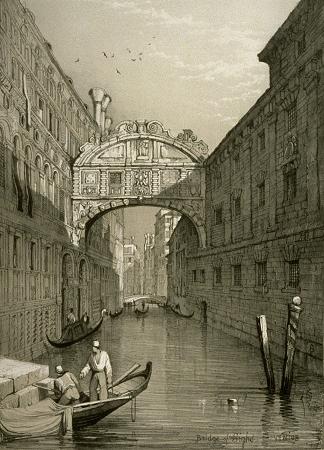
Bridge of Sighs. The Bridge of Sighs is a bridge in Venice, Italy.
The enclosed bridge is made of white limestone, has windows with stone bars, passes over the Rio di Palazzo, and connects the New Prison to the interrogation rooms in the Doge's Palace. It was designed by Antonio Contino, whose uncle Antonio da Ponte designed the Rialto Bridge, and it was built in 1600.
The view from the Bridge of Sighs was the last view of Venice that convicts saw before their imprisonment. The bridge's English name was bequeathed by Lord Byron in the 19th century as a translation from the Italian Ponte dei sospiri, from the suggestion that prisoners would sigh at their final view of beautiful Venice through the window before being taken down to their cells.
In reality, the days of inquisitions and summary executions were over by the time that the bridge was built, and the cells under the palace roof were occupied mostly by small-time criminals. In addition, little could be seen from inside the bridge due to the stone grills covering the windows.
The 1861 opera Le pont des soupirs by Jacques Offenbach features the bridge, as does the song Venice by Gibraltarian band Melon Diesel. French-American singer-songwriter Charles Aznavour recorded his famous song Que C'est Triste Venise in 1964. Its lyrics make reference to the bridge and to several other Venetian features. Bridge of Sighs is also both a 1974 album and
The enclosed bridge is made of white limestone, has windows with stone bars, passes over the Rio di Palazzo, and connects the New Prison to the interrogation rooms in the Doge's Palace. It was designed by Antonio Contino, whose uncle Antonio da Ponte designed the Rialto Bridge, and it was built in 1600.
The view from the Bridge of Sighs was the last view of Venice that convicts saw before their imprisonment. The bridge's English name was bequeathed by Lord Byron in the 19th century as a translation from the Italian Ponte dei sospiri, from the suggestion that prisoners would sigh at their final view of beautiful Venice through the window before being taken down to their cells.
In reality, the days of inquisitions and summary executions were over by the time that the bridge was built, and the cells under the palace roof were occupied mostly by small-time criminals. In addition, little could be seen from inside the bridge due to the stone grills covering the windows.
The 1861 opera Le pont des soupirs by Jacques Offenbach features the bridge, as does the song Venice by Gibraltarian band Melon Diesel. French-American singer-songwriter Charles Aznavour recorded his famous song Que C'est Triste Venise in 1964. Its lyrics make reference to the bridge and to several other Venetian features. Bridge of Sighs is also both a 1974 album and
Wikipedia ...